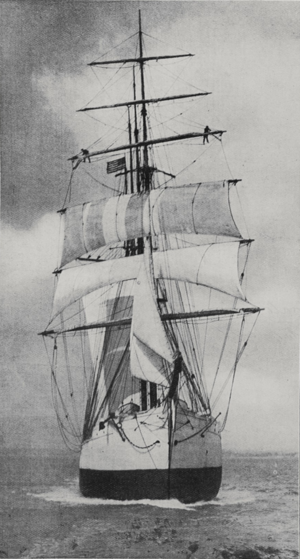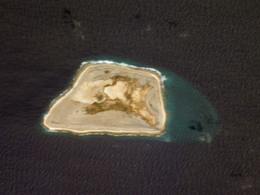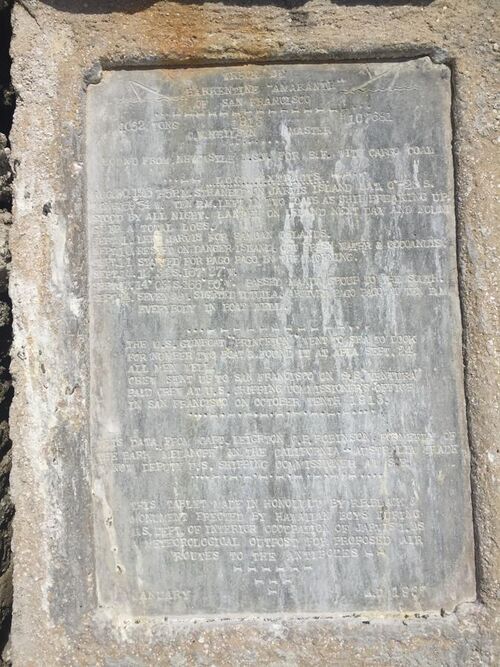Amaranth (barquentine)
Topic: Engineering
 From HandWiki - Reading time: 4 min
From HandWiki - Reading time: 4 min
 Amaranth under sail
| |
| History | |
|---|---|
| Name: | Amaranth |
| Builder: | Matthew Turner, Benicia, CA |
| Launched: | 1901 |
| Fate: | Wrecked at Jarvis Island, Aug. 30, 1913, [ ⚑ ] : 0°22′50″S 159°59′56″W / 0.38056°S 159.99889°W |
| General characteristics | |
| Class and type: | 4-masted barquentine |
| Tons burthen: | 1,109 [1] |
| Sail plan: | Barquentine[1] |
Amaranth was a four-masted barquentine built by Matthew Turner of Benicia, California in 1901. Amaranth sailed in the China trade between Puget Sound and Shanghai. She was wrecked on a guano island in the South Pacific in 1913 while carrying a load of coal.
Construction
Barquentine Amaranth Co. incorporated in San Francisco on Sept. 14, 1901 with capital stock of $76,000 and was assigned state corporation no. 33,965.[2] Captain Turner, a master shipbuilder, was known for his Bering Sea pelagic sealing schooners, codfishing schooners, South Seas schooners, and sugar packets.[3] Amaranth measured 1,109 tons, and was a sister ship to Turner's 1,167 ton barquentine Amazon.[1][4] The ship was named after the amaranth plant.
In 1975, a half-hull model of Amaranth was on display in the San Francisco Maritime Museum.[5] By 1941, the Historic American Merchant Marine project had collected and deposited the complete plans of Amaranth at the US National Museum.[6]
Voyages to China
Amaranth sailed from Astoria, Oregon to Shanghai in 23 days. She also made four voyages under Captain E.C. Boles from Puget Sound to Taku, (Shanghai), "in 100, 110, 118, and 123 days."[3]
Delivery of drydock materials to Pearl Harbor
In April 1910, Amaranth delivered materials for construction of a drydock facility at Pearl Harbor. Amaranth was the fourth deep-sea, cargo-carrying vessel to venture into the newly dredged harbor, where a naval station was planned, having been preceded by the three-masted schooner W.H. Marston on March 8, and the schooner Ariel and bark Marston a few days later.[7]
Shipwreck at Jarvis Island

On 30 August 1913, Amaranth, under Captain C.W. Nielson, was carrying a cargo of coal from Newcastle, New South Wales to San Francisco when she wrecked on the southeastern shore of Jarvis Island.[1][8] On shore, the Amaranth crew could see the ruins of ten wooden guano-mining buildings, including a two-story house. "The captain and crew took to their boats and landed next morning. The vessel broke up. With salvaged provisions and water, the crew managed to reach Samoa in the two boats 3 weeks later."[9] One lifeboat reached Pago Pago, American Samoa and the other made Apia in Western Samoa.
The Amaranth's scattered remains were noted and scavenged for many years, and rounded fragments of coal from the ship's hold were still being found on the south beach in the late 1930s.[10] "A memorial cairn and plaque that commemorate the grounding are still present on the island."[9]
Plaque
| Amaranth Monument Plaque | Amaranth Monument Plaque |
|---|---|
| WRECK OF BARKENTINE "AMARANTH" ... H H LOG EXTRACTS H H ... SEPT 1. LEFT JARVIS FOR SAMOAN ISLANDS. SEPT 13. 14°03'S.166°50'W. PASSED MANUA GROUP TO THE SOUTH. ... H H H H H H H H H H H ... THIS DATA FROM CAPT. LEIGHTON C.P. ROBINSON. FORMERLY OF THIS TABLET MADE IN HONOLULU BY R.B.BLACK & |
References
- ↑ 1.0 1.1 1.2 1.3 Gibbs, Jim (1968). West Coast Windjammers in Story and Pictures. Seattle: Superior Publishing Co. p. 136. ISBN 978-0-517-17060-1.
- ↑ Report of Secretary of State, p. 27
- ↑ 3.0 3.1 Gibbs, Jim (1968). West Coast Windjammers in Story and Pictures. Seattle: Superior Publishing Co. pp. 40–45. ISBN 978-0-517-17060-1.
- ↑ Riegel, Martin P (1987). California's maritime heritage. San Clemente, CA: Riegel Pub. Co. p. 21. OCLC 17212276. https://www.google.com/search?tbm=bks&q=amaranth+barquentine&btnG=Search+Books.
- ↑ Kranz, Jacqueline Longaker (1975). American nautical art and antiques. New York: Crown Publishers. p. 55. ISBN 9780517518915. https://books.google.com/books?id=B_oNAQAAIAAJ&q=amaranth+.
- ↑ Lyman, John (1941). The sailing vessels of the Pacific coast and their builders, 1850-1905. San Diego: Maritime Research Society of San Diego. p. 20. ISBN 9780517518915. OCLC 16000833. https://books.google.com/books?id=q2AhAQAAIAAJ&q=amaranth+barkentine. ("The Historic American Merchant Marine project has collected and deposited in the US National Museum lines of the schooner Lily and complete plans of schooner Commerce, barkentines Kohala, Amazon and Amaranth, and bark Newsboy.")
- ↑ Thrum, Thos. G (1910). All about Hawaii. The recognized book of authentic information on Hawaii, combined with Thrum's Hawaiian annual and standard guide. Honolulu. Honolulu: Honolulu Star-Bulletin. pp. 163–164. OCLC 1663720. https://books.google.com/books?id=R-sKAAAAIAAJ&dq=amaranth+barkentine&pg=RA1-PA163.
- ↑ Bryan, E H (1942). American Polynesia and the Hawaiian Chain. Honolulu, Hawaii: Tongg Pub. Co. p. 134. OCLC 1036237. https://books.google.com/books?id=MbQbAAAAIAAJ&q=amaranth+barkentine.
- ↑ 9.0 9.1 US Fish & Wildlife Service. "Jarvis Island National Wildlife Refuge". Jarvis Island National Wildlife Refuge Interpretation. US Fish & Wildlife Service. http://www.fws.gov/refuges/profiles/History.cfm?ID=12513. Retrieved Feb 26, 2011.
- ↑ Bryan, E.H. "Jarvis Island" Retrieved: 7 July 2008.
External links
- Mathew Turner, Benicia’s shipbuilder extraordinaire, by Jerry Bowen
 |
 KSF
KSF
